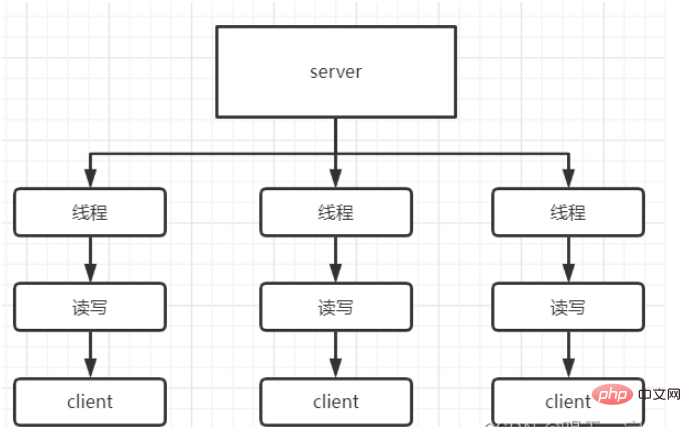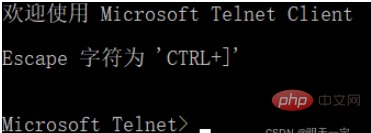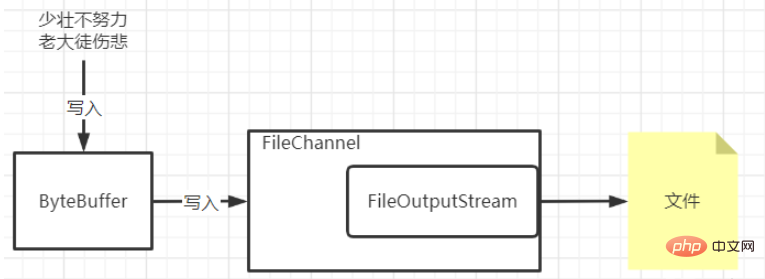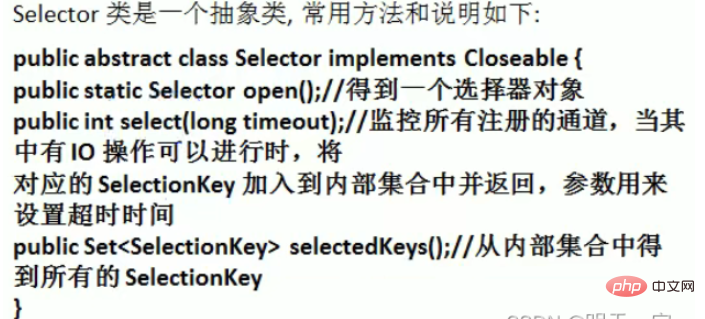Présentation du modèle Java IO et du framework Netty
什么是Netty
异步,基于事件驱动的网络应用框架,用以快速开发高性能,高可靠的网络IO程序
主要针对在TCP协议下,面向Clients端的高并发应用
本质是一个NIO框架,适用于服务器通讯等场景
异步:发送请求无需等待响应,程式接着往下走。
事件驱动:一个连接事件或者断开事件,或者读事件或者写事件,发生后的后续处理。

Netty典型应用:
高性能rpc框架用来远程服务(过程)调用,比如Dubbo。
游戏行业,页面数据交互。
大数据领域如Hadoop高性能通讯和序列化组件(AVRO)。
IO模型
简单理解就是用什么通道去进行数据发送和接收。
BIO:一个连接一个线程,连接不做任何事会造成不必要的线程开销。适用于连接数目较小且固定的架构。

NIO:服务端一个线程(也可以多个),维护一个多路复用器。由多路复用器去处理IO线程。适用于连接数目多且较短的架构

AIO:异步非阻塞,还未得到广泛应用。适用于连接数目多且连接较长的架构。
BIO
BIO编程简单流程
服务端创建启动ServerSocket
客户端启动Socket对服务器进行通信,默认服务器会对每一个客户创建一个线程。
客户端发出请求后,先咨询线程是否有响应,如果没有则等待或者拒绝。
如果有响应,则等待请求结束后,再继续执行。(阻塞)
BIO简单实例
public class BIOserver {
public static void main(String[] args) throws IOException {
// 为了方便直接用了Executors创建线程池
ExecutorService service = Executors.newCachedThreadPool();
//指定服务端端口
ServerSocket serverSocket = new ServerSocket(6666);
System.out.println("服务器启动");
while(true){
//阻塞等待连接
Socket socket = serverSocket.accept();
System.out.println("连接到一个客户端");
//每个连接对应一个线程
service.execute(new Runnable() {
@Override
public void run() {
try {
handler(socket);
}catch (Exception e){
e.printStackTrace();
}
}
});
}
}
public static void handler(Socket socket) throws IOException {
System.out.println("Thread:"+Thread.currentThread().getId());
byte[] bytes = new byte[1024];
InputStream inputStream = socket.getInputStream();
while (true){
//阻塞等待读取
int n = inputStream.read(bytes);
if(n!=-1){
System.out.println(new String(bytes,0,n));
}else {
break;
}
}
socket.close();
}
}测试:使用windows的telnet

使用 ctrl+]


可以在服务端控制台看到,已经读取到发送的数据

NIO
三大核心部分:Channel(可类比Socket),Buffer,Selector
大概是这个样子。客户端和Buffer交互,Buffer和Channel是一对一的关系。Selector选择操作Channel(事件驱动,如果Channel有事件发生,Selector才去选择操作。)

Buffer
Buffer基本使用
ByteBuffer使用场景较为广泛。
buffer就是一个内存块,所以说nio是面向块/缓冲,底层是数组。数据读写是通过buffer。可以使用方法flip切换读写。
public class BufferNio {
public static void main(String[] args) {
//创建buffer容量为5个int
IntBuffer buffer = IntBuffer.allocate(5);
//放数据
buffer.put(1);
buffer.put(2);
buffer.put(3);
buffer.put(4);
buffer.put(5);
//读写切换
buffer.flip();
//取数据
//内部维护一个索引,每次get索引都会往后边移动
while(buffer.hasRemaining()){
System.out.println(buffer.get());
}
}
}Buffer四个主要属性
// Invariants: mark <= position <= limit <= capacity
private int mark = -1;
private int position = 0;
private int limit;
private int capacity;mark:标记,很少改变
position:下一个要被读元素的位置,为下次读写做准备
limit:缓冲器当前的终点,不能对缓冲区极限意外的区域读写,可变。
capacity:不可变,创建时指定的最大容量。
上边出现了读写切换的方法flip,我们看下源码,可以看出来通过改变属性实现可读可写的。
public final Buffer flip() {
limit = position;
position = 0;
mark = -1;
return this;
}可以通过啊更改limit或者position来实现你想要的操作。参数自己决定
buffer.limit(2);
buffer.position(1);Channel
可读可写,上接Selector,下连Buffer。
当客户端连接ServerSocketChannel时,创建客户端自己的SocketChannel。
本地文件写案例
public class ChannelNio {
public static void main(String[] args) throws IOException {
String str = "少壮不努力,老大徒伤悲";
//创建输出流
FileOutputStream os = new FileOutputStream("D:\\xxxxxxxxxxxxxxxxxxx\\a.txt");
//获取FileChannel
FileChannel channel = os.getChannel();
//创建缓冲
ByteBuffer buffer = ByteBuffer.allocate(1024);
//把字符串放入缓冲区
buffer.put(str.getBytes());
//反转ByteBuffer
buffer.flip();
//将ByteBuffer写入到FileChannel
channel.write(buffer);
//关闭流
os.close();
}
}图示理解

本地文件读案例
public class ChannelNio {
public static void main(String[] args) throws IOException {
FileInputStream is = new FileInputStream("D:\\xxxxxxxxxxxxxxxxxxx\\a.txt");
FileChannel channel = is.getChannel();
ByteBuffer buffer = ByteBuffer.allocate(1024);
channel.read(buffer);
System.out.println(new String(buffer.array()));
is.close();
}
}本地文件拷贝案例
方法一
public class ChannelNio {
public static void main(String[] args) throws IOException {
FileInputStream is = new FileInputStream("D:\\xxxxxxxxxxxxxxxxxxx\\a.txt");
FileChannel channel = is.getChannel();
ByteBuffer buffer = ByteBuffer.allocate(1024);
FileOutputStream os = new FileOutputStream("D:\\xxxxxxxxxxxxxxxxxxx\\b.txt");
FileChannel osChannel = os.getChannel();
while (true){
buffer.clear();
int i = channel.read(buffer);
if(i==-1){
break;
}
buffer.flip();
osChannel.write(buffer);
}
is.close();
os.close();
}
}方法二
public class ChannelNio {
public static void main(String[] args) throws IOException {
FileInputStream is = new FileInputStream("D:\\xxxxxxxxxxxxxxxxxxx\\HELP.md");
FileChannel channel = is.getChannel();
FileOutputStream os = new FileOutputStream("D:\\xxxxxxxxxxxxxxxxxxx\\HELP222.md");
FileChannel osChannel = os.getChannel();
osChannel.transferFrom(channel,0,channel.size());
is.close();
os.close();
}
}Selector
用一个线程处理多个客户端连接。可以检测多个注册通道的事件,并作出相应处理。不用维护所有线程。

Selector peut obtenir un ensemble SelectionKey du SocketChannel enregistré, puis écouter la sélection, obtenir la SelectionKey lorsqu'un événement se produit et enfin obtenir le canal via la SelectionKey pour effectuer les opérations correspondantes et terminer l'affaire.
Ce qui précède est le contenu détaillé de. pour plus d'informations, suivez d'autres articles connexes sur le site Web de PHP en chinois!

Outils d'IA chauds

Undresser.AI Undress
Application basée sur l'IA pour créer des photos de nu réalistes

AI Clothes Remover
Outil d'IA en ligne pour supprimer les vêtements des photos.

Undress AI Tool
Images de déshabillage gratuites

Clothoff.io
Dissolvant de vêtements AI

AI Hentai Generator
Générez AI Hentai gratuitement.

Article chaud

Outils chauds

Bloc-notes++7.3.1
Éditeur de code facile à utiliser et gratuit

SublimeText3 version chinoise
Version chinoise, très simple à utiliser

Envoyer Studio 13.0.1
Puissant environnement de développement intégré PHP

Dreamweaver CS6
Outils de développement Web visuel

SublimeText3 version Mac
Logiciel d'édition de code au niveau de Dieu (SublimeText3)
 Nombre parfait en Java
Aug 30, 2024 pm 04:28 PM
Nombre parfait en Java
Aug 30, 2024 pm 04:28 PM
Guide du nombre parfait en Java. Nous discutons ici de la définition, comment vérifier le nombre parfait en Java ?, des exemples d'implémentation de code.
 Générateur de nombres aléatoires en Java
Aug 30, 2024 pm 04:27 PM
Générateur de nombres aléatoires en Java
Aug 30, 2024 pm 04:27 PM
Guide du générateur de nombres aléatoires en Java. Nous discutons ici des fonctions en Java avec des exemples et de deux générateurs différents avec d'autres exemples.
 Weka en Java
Aug 30, 2024 pm 04:28 PM
Weka en Java
Aug 30, 2024 pm 04:28 PM
Guide de Weka en Java. Nous discutons ici de l'introduction, de la façon d'utiliser Weka Java, du type de plate-forme et des avantages avec des exemples.
 Numéro de Smith en Java
Aug 30, 2024 pm 04:28 PM
Numéro de Smith en Java
Aug 30, 2024 pm 04:28 PM
Guide du nombre de Smith en Java. Nous discutons ici de la définition, comment vérifier le numéro Smith en Java ? exemple avec implémentation de code.
 Questions d'entretien chez Java Spring
Aug 30, 2024 pm 04:29 PM
Questions d'entretien chez Java Spring
Aug 30, 2024 pm 04:29 PM
Dans cet article, nous avons conservé les questions d'entretien Java Spring les plus posées avec leurs réponses détaillées. Pour que vous puissiez réussir l'interview.
 Break or Return of Java 8 Stream Forach?
Feb 07, 2025 pm 12:09 PM
Break or Return of Java 8 Stream Forach?
Feb 07, 2025 pm 12:09 PM
Java 8 présente l'API Stream, fournissant un moyen puissant et expressif de traiter les collections de données. Cependant, une question courante lors de l'utilisation du flux est: comment se casser ou revenir d'une opération FOREAK? Les boucles traditionnelles permettent une interruption ou un retour précoce, mais la méthode Foreach de Stream ne prend pas directement en charge cette méthode. Cet article expliquera les raisons et explorera des méthodes alternatives pour la mise en œuvre de terminaison prématurée dans les systèmes de traitement de flux. Lire plus approfondie: Améliorations de l'API Java Stream Comprendre le flux Forach La méthode foreach est une opération terminale qui effectue une opération sur chaque élément du flux. Son intention de conception est
 Horodatage à ce jour en Java
Aug 30, 2024 pm 04:28 PM
Horodatage à ce jour en Java
Aug 30, 2024 pm 04:28 PM
Guide de TimeStamp to Date en Java. Ici, nous discutons également de l'introduction et de la façon de convertir l'horodatage en date en Java avec des exemples.
 Programme Java pour trouver le volume de la capsule
Feb 07, 2025 am 11:37 AM
Programme Java pour trouver le volume de la capsule
Feb 07, 2025 am 11:37 AM
Les capsules sont des figures géométriques tridimensionnelles, composées d'un cylindre et d'un hémisphère aux deux extrémités. Le volume de la capsule peut être calculé en ajoutant le volume du cylindre et le volume de l'hémisphère aux deux extrémités. Ce tutoriel discutera de la façon de calculer le volume d'une capsule donnée en Java en utilisant différentes méthodes. Formule de volume de capsule La formule du volume de la capsule est la suivante: Volume de capsule = volume cylindrique volume de deux hémisphères volume dans, R: Le rayon de l'hémisphère. H: La hauteur du cylindre (à l'exclusion de l'hémisphère). Exemple 1 entrer Rayon = 5 unités Hauteur = 10 unités Sortir Volume = 1570,8 unités cubes expliquer Calculer le volume à l'aide de la formule: Volume = π × r2 × h (4






